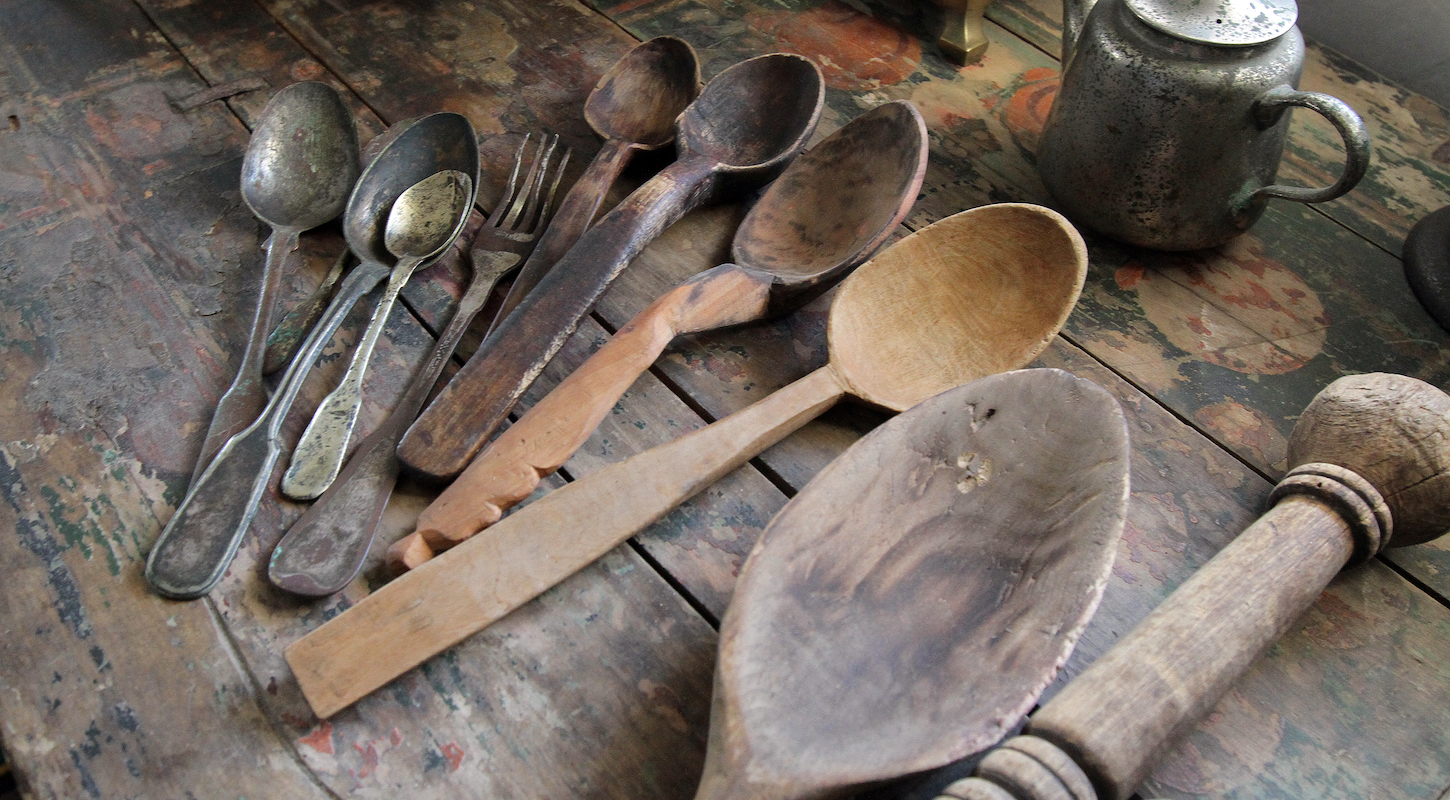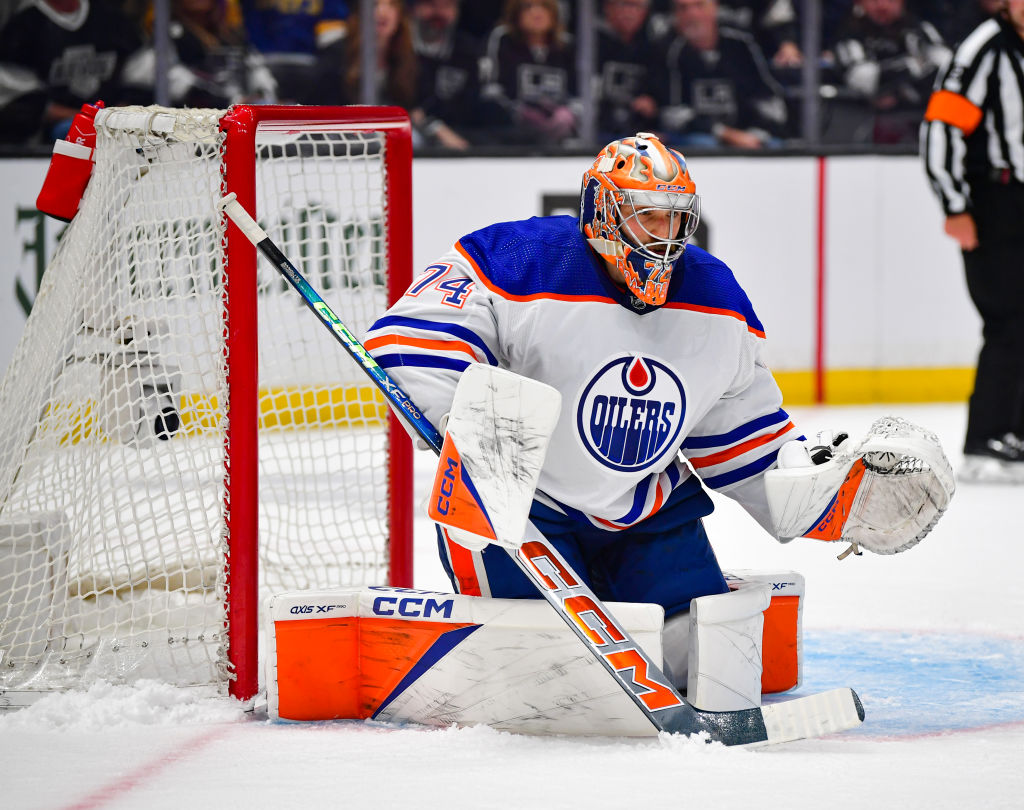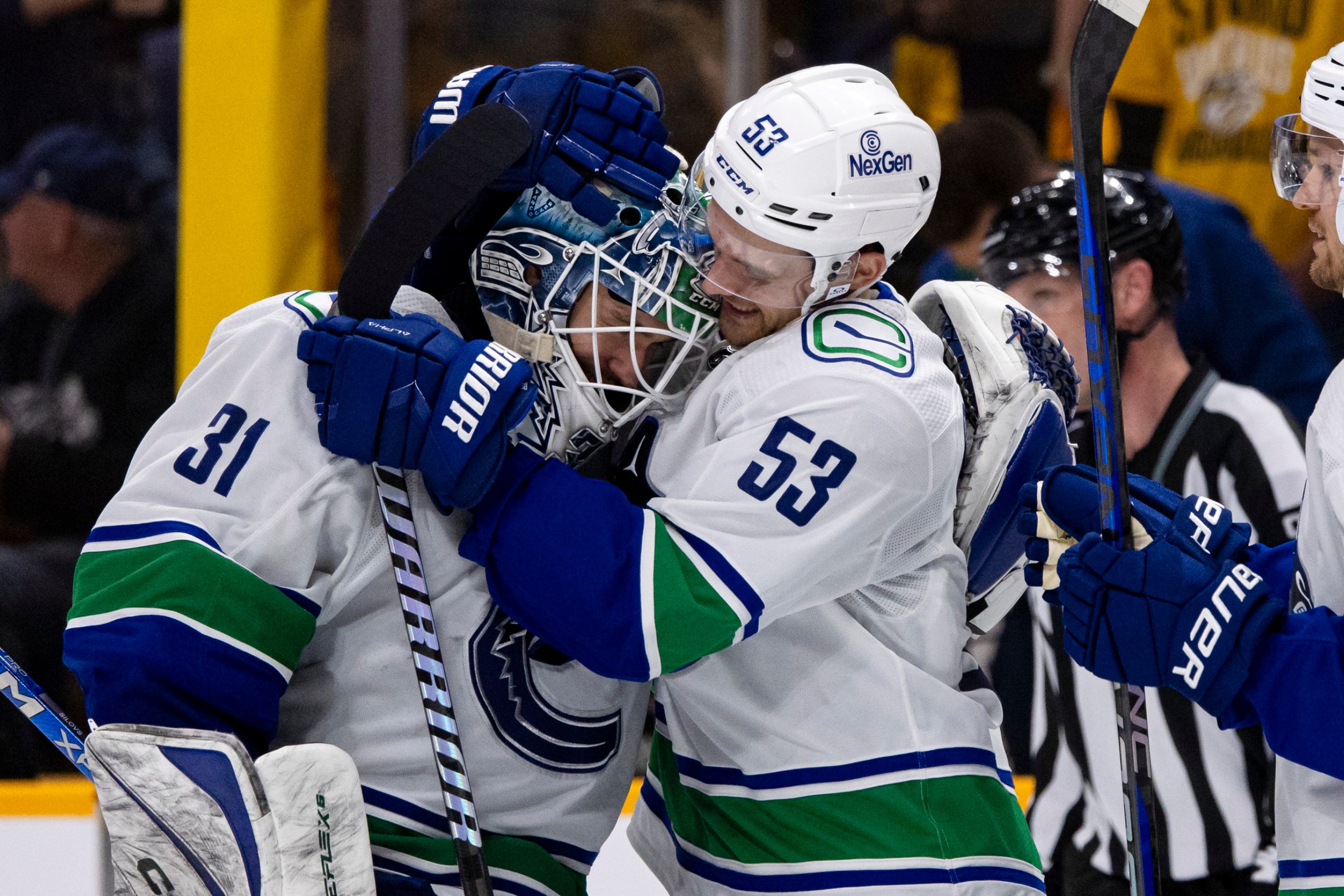A Journey To Korea In Search Of The Bank-Shot Free Throw
11:52 AM EDT on April 15, 2024
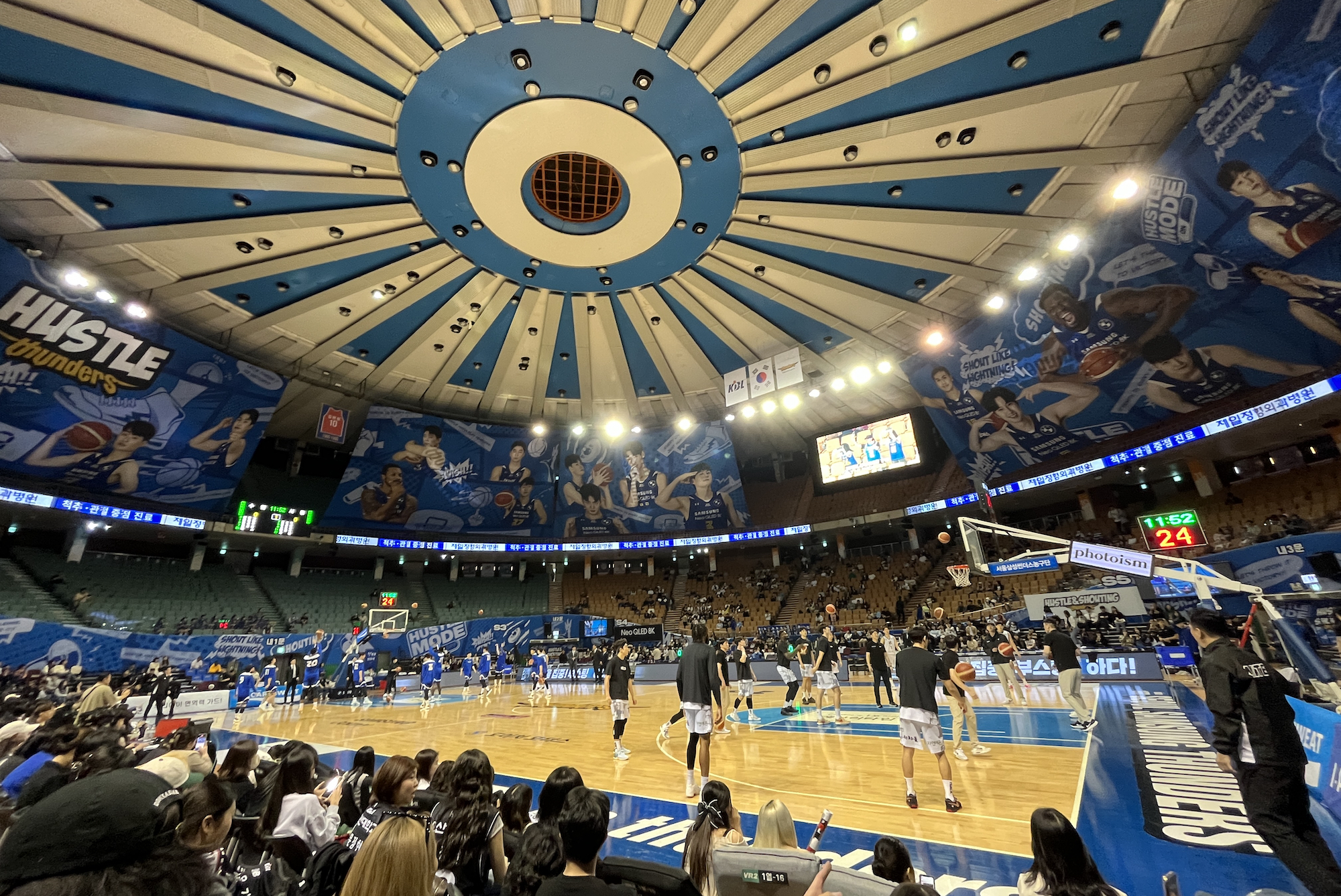
One weekend afternoon, in early November, my mother and I scurried through a bustling pedestrian plaza ringed with food trucks in southeast Seoul, eager to get to our first-ever Korean Basketball League game. Screeching into the will-call line, we waited briefly, if impatiently, beneath a blue sign with puffy white letters reminiscent of comic book onomatopoeia, spelling out the official English motto of the home team, the Seoul Thunders (not to mention offering an unofficial slogan for the two-and-a-half-week bonding trip around my mom’s native country that the two of us were then on together): “HUSTLE & SHOUTING.”
Tickets secured, we breezed into Jamsil Arena without so much as passing under a metal detector or removing our wallets, alongside fellow spectators munching on tteok-kkochi skewers and sipping bubble teas that they weren’t forced to toss. Once inside, I headed for the bathroom only to find myself flanked at the next urinal by a towering member of the opposing Suwon Sonicboom, whose post-pee return to pregame warmups was interrupted when five fans cornered the big man into posing for pictures. To his credit, the player obliged each request before politely excusing himself to rejoin his teammates.
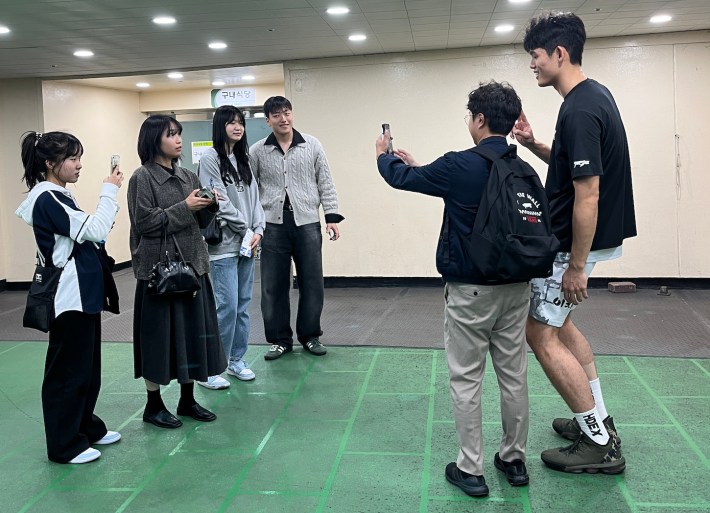
Notable as they were compared to the usual pro hoops milieu back home, though, I knew campy club mottos and lax stadium security wouldn’t be the most unfamiliar part of my introductory Korean basketball experience. Ditto for the giant TV that a pair of latex-gloved Thunder team staffers would later escort to midcourt during a timeout for the grand prize in a shooting contest. (The contestant airballed his heave and the flatscreen was hauled off.) After all, I had specifically requested that we fit this game into our packed itinerary for a single reason:
I wanted to see the bank-shot free throw.
Like many stateside, my introduction to the concept of the Korean bank-shot free throw came courtesy of an August 2023 tweet from Eric Fawcett, a video coordinator in the Canadian Elite Basketball League. “Interesting trend from the [KBL] where a number of players are 80[-percent]+ from the free throw line shooting exclusively bank shots,” Fawcett wrote, appending a video of example clips that has since drawn close to 4 million views.
Countless spinoff posts followed, from a YouTube video labeled “South Korean Weird Free Throw Method” (5 million views) to a Slate article titled “A Viral Clip From the Korean Basketball League Could Change the World.” And later, three days apart in late November, the New York Times and the Wall Street Journal published trend pieces exploring the cultural phenomenon, the latter of which was seducingly headlined “NBA Stars, Fix Your Free Throws With One Easy Trick.”
The 2023-24 KBL season, now into the playoffs, gave no indication that this trend is abating: Entering the final week of the regular season, 13 of the league’s top 20 free-throw shooters with at least one attempt per game—and seven of the top 10, and three of the top four—preferred caroming the ball off the backboard rather than seeking the usual, wholly approved swish. Headlining the list was No. 1–ranked Choi Buk-yung of Seoul’s other squad, the Knights, who was sinking bank-shot free throws at a clip (90.1 percent) that would slot into a tie for sixth among NBA players.
Settling into our cheap lower-bowl seats—the upper section was blocked off by banners of Thunders players making action poses below speech bubbles containing more comic-book-esque rallying cries like “LET’S THROW IT TO VICTORY!!” and “SHOUT LIKE LIGHTNING!”—we didn’t have to wait long for our main attraction. As warmups wound down, I watched Thunders center Lee Weon-seok step to the line, size up his aim and, in a final act of practice, heave a pair of attempted banks that instead bricked off the rim.
Lee didn’t improve much after tipoff, earning five first-half free throws but connecting on just two. On the other end, however, I was delighted to watch my bathroom buddy—star Sonicboom center, Ha Yun-gi, it turned out—sink all four of his chances before halftime, also via the bank. Another devotee revealed himself in the third quarter when veteran Thunders guard Lee Jung-hyun went 2-for-2 in his lone trip, adding to a season-long success rate (79.4 percent) through March 24 that ranked 19th in the KBL.
We ultimately ducked out early to meet some family for dinner but, for what it’s worth, both teams had logged nearly identical percentages on bank shots (10-for-13, 77 percent) and normal free throws (19-for-25, 76 percent) through three quarters. Still, as we headed for the Seoul subway, I had more questions than when we arrived. How did such a distinct way of performing such a specific part of the game come to populate this particular corner of it? Why hasn’t the method caught on elsewhere? And what do bank-shot free throws reveal about the one culture that has embraced it—or, maybe, the rest that haven’t?
One thing was clear: None of the local fans were this obsessed.
“It’s pretty natural for Korean people to watch those bank-shot free throws,” Lyu Se-young, a Seoul-based sports marketing agent, told me over the phone soon thereafter. “So we don’t think much about it.”
A week or so later, on the road in the southwestern city of Gwangju, I placed a WhatsApp call to one of Lyu’s clients, Seoul Thunders assistant coach Brian Kim. Born in Seoul but raised overseas from age 11 after his family migrated to British Columbia, Kim didn’t realize that bank-shot free throws were even a thing until he finished college ball at Division II Vanguard (Calif.) University in ‘05 and returned to launch his pro career in the KBL.
“I never would’ve imagined banking a free throw,” Kim said. “Why would you do that? In college, banking was a sign of weakness to some. You only bank a layup, or maybe a hook shot.”
Now, by contrast, Kim, who has worked for the Thunders since 2021 after COVID-19 abruptly ended a two-year assistant coaching stint with the Detroit Pistons’ G-League affiliate, describes the bank-shot free throw as “a tradition for Korean basketball.” And while Kim never used it himself, he has become well-versed in its history too.
“The KBL had a legendary shooter, Moon Kyung-eun,” Kim said. “I think a lot of kids followed his routine, and that trickled down.”
Blessed with the nickname “Rambo Shooter” by Korean media and fans—both for the reckless offensive style that he brought to KBL courts in the ‘90s and ‘00s, and because evidently he bore a resemblance to Sylvester Stallone—Moon retired after the 2009–10 season with a sterling legacy featuring an Olympics appearance, an Asian Games gold medal, and the KBL record for career made three-pointers. He also held the league mark for consecutive made free throws, with 52, set in 2008–09 using the bank-shot method.
But Moon wasn’t always a convert. “[W]hen I threw a free throw, it hit the back of the rim and bounced out,” Moon told Korea’s Chosun Ilbo newspaper in early 2014, recalling his early struggles upon leaving Yonsei University and joining the Korean semi-pro basketball ranks that eventually spawned the KBL, “so I tried taking a step back to throw the ball, but I felt it wasn't to my advantage.” And even after he began banking his attempts with regularity, Moon was hardly hailed as a revolutionary. “At the time, swish [tong-syu] shots were the rule,” he told Korea’s Yonhap News Agency late last year. “So if you hit the backboard, people would say, ‘What is that guy?’ and ‘He’s arrogant.’” (Big shoutout to my mom and her friend for helping perfect the translations.)
While Moon tends to get the credit for popularizing the style—the Journal declared that “the origins of the Korean bank-shot free throw trace back to” him—he wasn’t its true originator. That honor instead belongs to Moon’s senior and mentor throughout high school and college, a 5-foot-11 guard with thick ankles named Kim Hyeon-jun, otherwise known as the “Electronic Shooter” for his automatic offense (and because Samsung sponsored his team). “The bank shot was Kim Hyun-jun's trademark,” Korea’s largest newspaper, JoongAng Ilbo, wrote in 2018.
Given his stumpy stature, the late Kim Hyeon-jun generally gravitated to the bank shot out of necessity as a player in the ‘80s and early ‘90s. “I thought it would be much better to hit the backboard than to try to avoid the opponent’s defense and take a shot,” he once said, according to the Korean blog Jumpball. “Bank shots have a high probability regardless of conditions.” Unorthodox as the form was from the stripe in particular, the results were hard to dispute; according to one former national team coach, it wasn’t uncommon for Kim Hyeon-jun to casually sink 90-plus banked free throws in a row.
Kim Hyeon-jun died in a car crash in October 1999, at age 39, riding in a taxi from his home to his then-job as the Thunders’ head coach—though not before, years earlier, convincing his prized pupil to adopt the signature style. “From then on,” Moon told Chosun, “I [used] the backboard and it went well.” But the tragedy meant that the Electronic Shooter never got to witness his legacy spreading to future generations: Less than 20 years later, during the 2015–16 season, a full starting lineup’s worth of KBL all-stars were regular free-throw bankers; among the five was Lee Jung-hyun, the Thunders guard, who has told reporters that watching Moon inspired him to start shooting that way in middle school.
All the more curious, then, is what Moon, now in the KBL front office as the league’s head of competition, said to Yonhap late last year: “If I were a coach, I wouldn’t recommend it. Young players especially shouldn’t learn that way.” It is a similar version of what Brian Kim told his former G-League peers back in North America around the same time, as Fawcett’s video compilation was making the social-media rounds.
“They were like, ‘The bank shot is very interesting, Brian, do you teach that?’” Brian Kim told me. “And I’m like, ‘No, I don’t think anyone would recommend shooting bank free throws over here—unless you’re shooting, like, 30 percent and trying to fix it.”
Bob Thornton has spent nearly 40 years crisscrossing the professional basketball landscape as a player, coach, and scout, including stops with nine NBA teams. But he wasn’t prepared for the singular surprise of encountering his first bank-shot free throw in the wild after he joined the KBL’s Wonju Promy as an assistant this season.
“It’s like, omigod, did he do that on purpose?” Thornton told me. “I’d never seen that before.” Once the shock subsided, though, Thornton grew to accept the bank shot as an integral part of the Korean game. “You think it’s a gimmick, but we just have some guys who shoot it like that consistently,” Thornton said. “So it’s like, ‘OK, that’s your shot then. Whatever works for you.’”
And what goes into making the bank-shot free throw work? While technically reliant on scientific concepts, like the momentum-reducing effect of the backboard and the advantageous angle created by a higher shot above the rim, the answer can seem elementary. As Thornton put it, “You hit the square in the right spot, it’s going in.”
To the Rambo Shooter, the proper form involved both universal physics and individual ability. “The key … is controlling the shot distance and rotating the ball,” Moon told the media outlet Hans Economy in January. “Because there are more things to pay attention to than just shooting a shot, it is advantageous to have a certain degree of natural shooting ability or to have feel for your fingertips through a lot of practice.”
In other words: Easier said than made, especially for those accustomed to aiming for the center of the rim. “I feel numbness in my hands [shooting bank-shot free throws],” Ha Seung-jin, a 7-foot-5 former center and 2004 second-round pick of the Trail Blazers who remains Korea’s only NBA player ever, described to Hans Economy. “To shoot [normally], you have to touch the ball with your fingertips and raise it to shoot, but a backboard shot feels like just hitting the backboard … We’re not playing darts, we’re playing basketball.”
Fatigue is also a factor, as Brian Kim notices from the Thunders bench whenever Lee Jung-hyun earns an attempt late in a game. “I can tell he’s going to shoot short because he’s short of breath, and he does shoot short, which for him is hitting the back of the rim. I’m thinking, ‘Why is he still shooting bank free throws even though he’s dead tired?” Another potential, albeit more helpful, variable is the state of the hoop itself. “KBL backboards are old and soft, and we don’t really replace the rims that often,” Brian Kim said, “so they’re more absorbing for contact with the ball.”
The bank free throw, then, would appear to be an ideal alternative for oafish big men unable to restrain their strength for a swish. (“I do it unintentionally sometimes,” then-Grizzlies center Steven Adams quipped last fall when asked about the Korean trend.) The Thunders had been attempting to convert second-year center Lee Weon-seok this season, but the results—as I saw in the Sonicboom game—refused to follow. “So we kind of re-fixed his shot to have him shoot normal,” Brian Kim said. “It may not work for people.”
Indeed, some players simply aren’t suited to the bank shot for physical reasons. But it will take more than simple belief in its benefits to see the method overcome certain cultural obstacles and meaningfully spread beyond the borders of where it bloomed. “I’ve only seen Korean players do it, and it’s mostly guys that’ve been playing for a long time,” Thornton said. “To get [NBA players] to incorporate that, when you’ve already established how you shoot the ball over thousands of hours, it’s going to be a major overhaul. If you want to try, good luck with you, I wish you all the best.”
For this reason and more, Brian Kim concluded, the fact that more people know about bank-shot free throws won’t necessarily result in more people doing them. “I don’t think the world saw it as, like, ‘Wow, we’ve got to try this,’” Kim said. “They just saw it as, ‘Oh, there’s an Asian country named Korea with a basketball league there, and guys are shooting bank-shot free throws, isn’t that weird?' I think that’s how they perceive it.”
Rod Benson fell in love with the backboard as a kid in southern California, drawn to its power through his favorite players. “I grew up studying Tim Duncan and Kevin Garnett, so my go-to move was a turnaround bank shot,” Benson, who played college ball at Cal from 2002–06 before beginning a journeyman pro career, told me. “And I would always have really bad starts of seasons with shooting free throws because that fall-away, off-the-glass style was a whole other motion. The Koreans were not having this.”
The issue reached a head during Benson’s second KBL campaign, in 2011–12, when a sluggish stretch led his Wonju Promy coach to issue an ultimatum. “He said, ‘You start shooting 70 percent at least, or use the backboard on your free throws, pick one,’” Benson recalled. “It sounded like a joke, but he was serious. But I rolled it out, and immediately I was like, ‘Oh this works, because I already shoot every shot off the glass anyway.’
“The only people who took exception to it were other Americans coming into the league. They’d be like, ‘Ay, yo, what did they do to you, bro? What’s wrong with you?’”
Ha Seung-jin faced an even harsher response after his trade to the Bucks, in the summer of 2006, following two seasons in Portland. “[An assistant] coach said, ‘Don’t shoot free throws like that, shoot cleanly,’” Ha told Hans Economy. But the big man soon found confidence in an unlikely source. “I went to [then-Milwaukee head] coach Terry Stotts … and talked about the backboard free throw,” Ha continued, according to the outlet. “He said he also shot like that when he was a European player.”
Speaking over the phone, Stotts confirmed that he indeed turned to bank-shot free throws during a prolonged slump in France in the late ‘80s, near the tail end of his playing career. When asked what motivated him to use bank shots specifically—and not, say, execute a less drastic mechanical overhaul—Stotts chuckled and replied, “Well, desperation.” But, as with Benson, the results ultimately made Stotts believe.
“I had a flat shot with a lot of backspin, and I ended up having a lot of success,” Stotts said. “I shot about 85 percent banking over a two-year period.”
Stotts couldn’t remember the exact conversation that Ha described (the latter only lasted with Milwaukee for three months before getting cut). But the veteran coach can nonetheless relate to the ridicule that Korean free-throw bankers can face abroad. “I came back to [North America’s Continental Basketball Association in ‘90–91] and did it for a few games, and there was certainly some giggling in the stands,” said Stotts, adding that “the rims were tighter and the backboards were a little firmer [than in France], so I switched back.”
And yet, until I reached Stotts for this story, the concept of other people banking their free throws—let alone more than half of the top free throw shooters in one country’s top league—was entirely unknown to him. “I didn’t know it was a Korean thing,” Stotts said. In this way, his path to the bank shot differed from other Americans who were inspired by seeing it up close in the KBL, such as Benson and, more recently, former Long Beach State swingman Eugene Phelps. “The Koreans, they all shoot like pretty good free throws,” Phelps told the Philippines' Sports Interactive Network in 2019. “[S]o I was just trying something new.”
To Stotts, whose return to the Bucks as rookie coach Adrian Griffin’s top assistant last summer ended when he abruptly resigned on the eve of the regular season, the bank-shot free throw is no different than other unusual forms employed by struggling players, like Spurs guard Jeremy Sochan’s one-handed, periscope approach. “There’s a stigma about being different, or admitting you can’t shoot the regular way,” Stotts said. “But Mason Plumlee switched to left-handed. The best free-throw shooter in league history, Rick Barry, shot underhand.”
So what, then, has kept the bank shot from joining these methods at an NBA free-throw line? Brian Kim has observed one possible reason. “It seems like all the Americans coming over [to the KBL] hate banking it, even on mid-range and paint shots,” said Kim, who finished out the ‘23-24 campaign as interim head coach for the last-place Thunders after his former boss stepped down midseason. “Maybe there’s the perception that bank shots hurt their pride.”
But self-assurance alone can’t account for why so many Koreans prefer bank-shot free throws over the otherwise near-uniform approach among the rest of the basketball world; imagine if the plurality of, say, Mexican baseball players took to gripping the bat six inches up from the knob, or underhand serves became a norm in Australian tennis. Here, Benson has a theory that speaks to broader cultural forces beyond individual on-court preference.
“Koreans think about maximizing efficiency before thinking about the creativity of the subject, so in basketball they’re really unique,” said Benson, whose five KBL seasons included back-to-back championships with Ulsan Phoebus. “The bank shot in general, but also a lot of other technical things like junked zones and cut timing—the amount of strategy in Korea is probably second to none, and the bank shot is an extension of that.”
Relayed Benson’s hypothesis in a recent call, near the end of the Thunders’ season, Kim agreed. “I think he’s dead-on there,” the coach said. “Koreans will find any possible way to make minor tweaks so they can have higher efficiency in a player or in a team.
“Even if it looks super-weird.”
Recommended
If you liked this blog, please share it! Your referrals help Defector reach new readers, and those new readers always get a few free blogs before encountering our paywall.
Alex Prewitt is a writer in Brooklyn. He shoots free throws the normal way.
Read More:
Stay in touch
Sign up for our free newsletter
